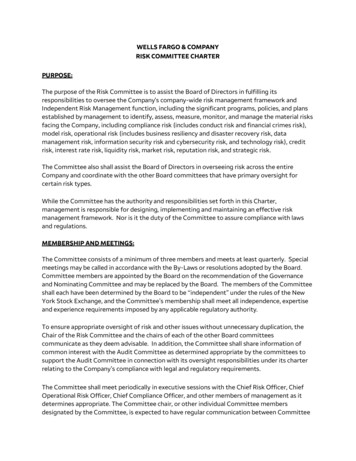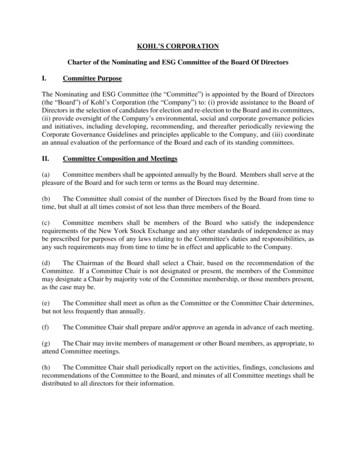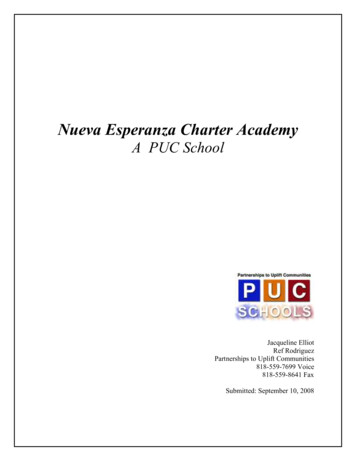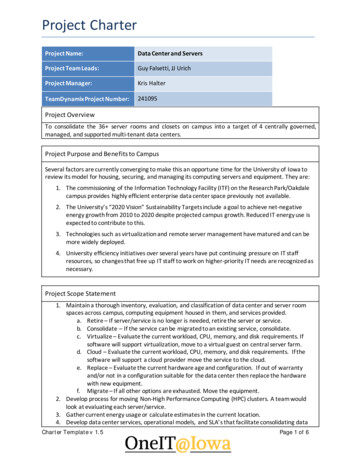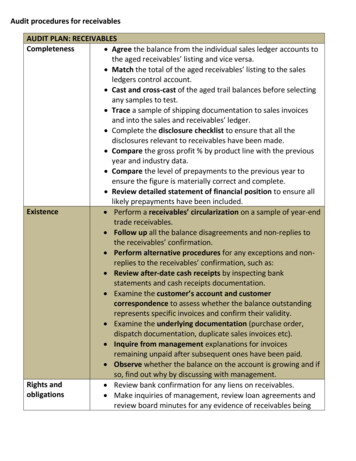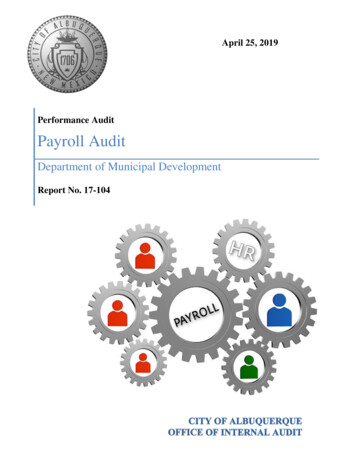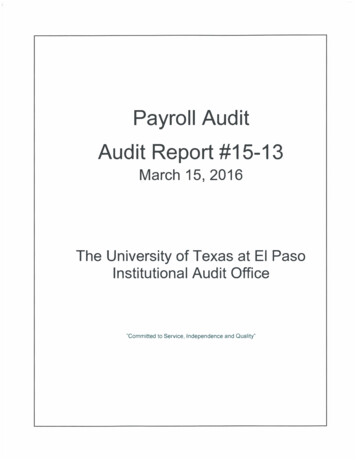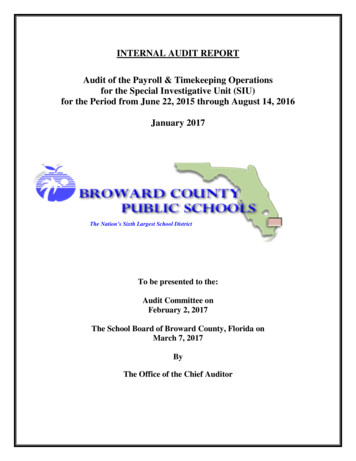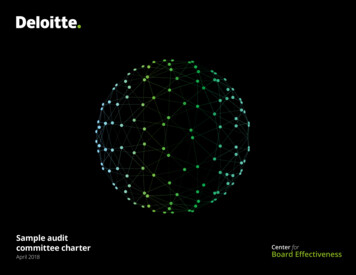
Transcription
Sample auditcommittee charterApril 2018Center forBoard Effectiveness
Sample audit committee charterSample auditcommittee charterThis sample audit committee charter is based on observations of selectedcompanies and the requirements of the SEC, the NYSE, and NASDAQ. Theinformation presented can and will change; we are under no obligation toupdate such information.1This template is designed for US public companies; exceptions to the requirements noted below may apply for certainissuers, including investment companies, small-business issuers, and foreign private issuers. Many of the itemspresented here are not applicable to voluntary filers. All companies should consult with legal counsel regarding theapplicability and implementation of the various requirements identified.Audit committee of the board of directors—charterI. Purpose and authorityThe audit committee is established by and among the board of directors for the primary purpose of assisting the board in: Overseeing the integrity of the company’s financial statements [NYSE Corporate Governance Rule 303A.07(b)(i)(A)] and the company’s accounting and financial reportingprocesses and financial statement audits [NASDAQ Corporate Governance Rule 5605(c)(1)(C)] Overseeing the company’s compliance with legal and regulatory requirements [NYSE Corporate Governance Rule 303A.07(b)(i)(A)] Overseeing the registered public accounting firm’s (independent auditor’s) qualifications and independence [NYSE Corporate Governance Rule 303A.07(b)(i)(A) andNASDAQ Corporate Governance Rule 5605(c)(1)(B)] Overseeing the performance of the company’s independent auditor and internal audit function [NYSE Corporate Governance Rule 303A.07(b)(i)(A)] Overseeing the company’s systems of disclosure controls and procedures Overseeing the company’s internal controls over financial reporting Overseeing the company’s compliance with ethical standards adopted by the company.1Deloitte LLP makes no representations as to the sufficiency of these tools for your purposes, and by providing them, we are not rendering accounting, business, financial, investment, legal, tax, or other professional adviceor services. These tools should not be viewed as a substitute for such professional advice or services, nor should they be used as a basis for any decision that may affect your business. Before making any decision or taking anyaction that may affect your business, you should consult a qualified professional adviser. Deloitte LLP does not assume any obligations as a result of your access to or use of these tools.2
Sample audit committee charterThe audit committee should encourage continuous improvement and should foster adherence to the company‘s policies, procedures, and practices at all levels. The auditcommittee has the authority to conduct investigations into any matters within its scope of responsibility and obtain advice and assistance from outside legal, accounting,or other advisers when necessary to perform its duties and responsibilities [Rule 10A-3(b)(4) of the Exchange Act, NYSE Corporate Governance Rule 303A.06, and NASDAQCorporate Governance Rule 5605(c)(3)].In carrying out its duties and responsibilities, the audit committee has the authority to engage outside legal, accounting, or other advisers [Rule 10A-3(b)(4) of the ExchangeAct, NYSE Corporate Governance Rule 303A.06, and NASDAQ Corporate Governance Rule 5605(c)(3)], and to seek any information it requires from employees, officers, anddirectors.1The company will provide appropriate funding, as determined by the audit committee, for compensation to the independent auditor, to any advisers that the audit committeechooses to engage, and for payment of ordinary administrative expenses of the audit committee that are necessary or appropriate in carrying out its duties. [Rule 10A-3(b)(5) ofthe Exchange Act, NYSE Corporate Governance Rule 303A.06, and NASDAQ Corporate Governance Rule 5605(c)(3)].The committee’s principal responsibility is one of oversight. The fundamental responsibility for the company’s financial statements and disclosures rests with management andthe independent auditor [general commentary to NYSE Corporate Governance Rule 303A.07(b)].II. Composition and meetings2The audit committee will comprise three or more directors as determined by the board [NYSE Corporate Governance Rules 303A.06 and .07(a) and NASDAQ CorporateGovernance Rule 5605(c)(2)(A)].Committee members will be appointed by the board at the annual organizational meeting of the board to serve until their successors are elected. Unless a chairman is electedby the full board, the members of the committee may designate a chairman by majority vote.Each audit committee member will meet the applicable standards of independence and the determination of independence will be made by the board and as defined byapplicable standards listing [Section 10A of the Exchange Act, NYSE Corporate Governance Rules 303A.06 and .07(a), and NASDAQ Corporate Governance Rule 5605(c)(2)(A)].All members of the committee must comply with all financial literacy requirements of the securities exchanges on which the company is listed. At least one member will qualify asan “audit committee financial expert” as defined by the SEC and determined by the board and appropriate disclosure will be made [Item 407(d)(5) of Regulation S-K, NYSE1NYSE Corporate Governance Rule 303A.09 requires companies to adopt and disclose guidelines for corporate governance that address their policies for directors’ access to management and independent advisers.2Consideration also should be given to the amount of time members of the audit committee can devote to the role. While there are currently no regulations limiting the number of public-company audit committees onwhich an individual may serve, some companies have included such limitations in the audit committee charter. Furthermore, the NYSE-required disclosures state: “If an audit committee member simultaneously serveson the audit committee of more than three public companies, the board must determine that such simultaneous service would not impair the ability of such member to effectively serve on the listed company‘s auditcommittee and disclose such determination either on or through the listed company’s website or in its annual proxy statement, or if the company does not file an annual proxy statement, in its annual report on Form 10-Kfiled with the SEC.3
Sample audit committee charterCorporate Governance Rule 303A.07(a), and NASDAQ Corporate Governance Rule 5605(c)(2)(A)].1 To help meet these requirements, the audit committee will provide itsmembers with annual continuing education opportunities in financial reporting and other areas relevant to the audit committee.2The board will determine that a director‘s simultaneous service on multiple audit committees will not impair the ability of such member to serve on the audit committee.3 Thecommittee will meet at least quarterly, or more frequently as circumstances dictate. The committee chairman will approve the agenda for the committee‘s meetings and anymember may suggest items for consideration. Briefing materials will be provided to the committee as far in advance of meetings as practicable.Each regularly scheduled meeting will conclude with an executive session of the committee absent members of management. As part of its responsibility to foster opencommunication, the committee will meet periodically with management, the director of the internal audit function, and the independent auditor in separate executive sessions[NYSE Corporate Governance Rule 303A.07(b)(iii)(E)].III. Responsibilities and dutiesTo fulfill its responsibilities and duties, the audit committee will:Documents/reports/accounting information reviewReview this charter at least annually and recommend any necessary amendments to the board of directors [NASDAQ Corporate Governance Rule 5605(c)(1)].Meet with management [Item 407(d)(3)(i)(A) of Regulation S-K] and the independent auditor to review and discuss the company‘s annual financial statements and quarterlyfinancial statements prior to the company‘s Form 10-K and 10-Q filings or release of earnings, including the company‘s disclosures under “Management‘s Discussion andAnalysis of Financial Condition and Results of Operations” [Item 303 of Regulation S-K and NYSE Corporate Governance Rule 303A.07(b)(iii)(B)]. Review internal control reports(or summaries thereof), other relevant reports or financial information submitted by the company to any governmental body or the public, and relevant reports rendered bythe independent auditor (or summaries thereof).Review internal control reports (or summaries thereof), other relevant reports or financial information submitted by the company to any governmental body or the public, andrelevant reports rendered by the independent auditor (or summaries thereof).Discuss the listed company’s earnings press releases, as well as financial information and earnings guidance provided to analysts and rating agencies, including the type andpresentation of information, paying particular attention to any pro forma or adjusted non-GAAP information. Such discussions may be in general terms (i.e., discussion of thetypes of information to be disclosed and the type of presentations to be made) [NYSE Corporate Governance Rule 303A.07(b)(iii)(C)].Review the regular internal reports to management (or summaries thereof) prepared by the internal audit function, as well as management‘s response.1NYSE Corporate Governance Rule 303A.07(a) requires all audit committee members to be ‘financially literate” as interpreted by the business judgment of the company’s board, or to become financially literate within areasonable period after being appointed to the committee. In addition, at least one member must have “accounting or related financial management expertise” as interpreted by the board. NASDAQ CorporateGovernance Rule 5605(c)(2)(A) requires all audit committee members to be able to read and understand financial statements at the time of their appointment to the committee and requires at least one auditcommittee member to be ‘financially sophisticated.” The SEC requires an issuer to disclose whether or not at least one audit committee financial expert serves on the audit committee. (Item 407 (d)(5)(i)(A)(1) and (2) ofRegulation S-K).2While the existence of a continuing education program for the board and audit committee is not a requirement, the NYSE Corporate Governance Rule 303A.09 requires companies to adopt and disclose guidelines forcorporate governance that address their policies for directors’ continuing education.3The disclosure requirement of NYSE Corporate Governance Rule 303A.07(a) states that if an audit committee member simultaneously serves on the audit committees of more than three public companies, the board mustdetermine that such simultaneous service does not impair the ability of such member to effectively serve on the listed company‘s audit committee and must disclose such determination either on or through the listedcompany‘s website, in its annual proxy statement, or, if the listed company does not file an annual proxy statement, in its annual report on Form 10-K filed with the SEC.4
Sample audit committee charterIndependent auditorAppoint (and recommend that the board submit for shareholder ratification, if applicable), compensate, retain, and oversee the work performed by the independent auditorretained for the purpose of preparing or issuing an audit report or related work, including the resolution of disagreements between management and the independent auditorregarding financial reporting [Rule 10A-3(b)(2) of the Exchange Act, NYSE Corporate Governance Rule 303A.06, and NASDAQ Corporate Governance Rule 5605(c)(3)]. Reviewthe qualifications and independence of the independent auditor and remove the independent auditor if circumstances warrant. The independent auditor will report directly tothe audit committee [Rule 10A-3(b)(2) of the Exchange Act].Review and preapprove (which may be pursuant to preapproval policies and procedures1) both audit and nonaudit services to be provided by the independent auditor[Section 10A(g) and (h) of the Exchange Act]. The authority to grant preapprovals may be delegated to one or more designated members of the audit committee, whosedecisions will be presented to the full audit committee at its next regularly scheduled meeting [Section 10A(i) of the Exchange Act]. Consider whether the auditor‘s provisionof permissible nonaudit services is compatible with the auditor‘s independence [Rule 2-01(c) of Regulation SX]. Actively engage in dialogue with the independent auditor withrespect to any disclosed relationships or services that may affect the independence and objectivity of the auditor and take appropriate actions to oversee the independence ofthe independent auditor [NASDAQ Corporate Governance Rule 5605(c)(1)(B)].Discuss with the independent auditor the matters required to be discussed under the standards of the PCAOB [Item 407(d)(3)(i)(B) of Regulation S-K].Review with the independent auditor any problems or difficulties encountered during the course of the audit, including any restrictions on the scope of the independentauditor’s activities or on access to requested information, and any significant disagreements with management, together with management’s response [NYSE CorporateGovernance Rule 303A.07(b)(iii)(F)].Hold timely discussions with the independent auditor regarding the following: All critical accounting policies and practices [Rule 2-07(a)(1) of Regulation S-X] All alternative treatments of financial information within generally accepted accounting principles related to material items that have been discussed with management,ramifications of the use of such alternative disclosures and treatments, and the treatment preferred by the independent auditor [Rule 2-07(a)(2) of Regulation S-X] Other material written communications between the independent auditor and management, including, but not limited to, the management letter and schedule ofunadjusted differences [Rule 2-07(a)(3) of Regulation S-X].At least annually, obtain and review a report by the independent auditor describing: The independent auditor‘s internal quality-control procedures [NYSE Corporate Governance Rule 303A.07(b)(iii)(A)] Any material issues raised by the most recent internal quality control review or peer review, or by any inquiry or investigation by governmental or professionalauthorities within the preceding five years with respect to independent audits carried out by the independent auditor, and any steps taken to deal with such issues[NYSE Corporate Governance Rule 303A.07(b)(iii)(A)] All relationships between the independent auditor and the company [NYSE Corporate Governance Rule 303A.07(b)(iii)(A)], addressing the matters set forth in PCAOBRule 3526 [Item 407(d)(3)(i)(C) of Regulation S-K].1Any policy under which audit or nonaudit services are preapproved needs to be detailed as to the particular services and the audit committee needs to be informed of each service [Rule 2-01(c) of Regulation S-X].5
Sample audit committee charterReview the experience and qualifications of the lead partner each year and determine that all partner rotation requirements, as promulgated by applicable rules andregulations, are executed. The audit committee should present its conclusions to the full board [commentary to NYSE Corporate Governance Rule 303A.07(b)(iii)(A)].Set policies, consistent with governing laws and regulations, for hiring personnel of the independent auditor [NYSE Corporate Governance Rule 303A.07(b)(iii)(G)].1Financial reporting processes, accounting policies, and internal control structureIn consultation with the independent auditor and the internal audit function, review the integrity of the company‘s internal and external financial reporting processes.Understand the scope of the audit plan, including the independent auditors’ review of internal control over financial reporting. Receive and review any disclosure from thecompany‘s CEO and CFO made in connection with the certification of the company‘s quarterly and annual reports filed with the SEC of: a) significant deficiencies and materialweaknesses in the design or operation of internal control over financial reporting which are reasonably likely to adversely affect the company‘s ability to record, process,summarize, and report financial data; and b) any fraud, whether or not material, that involves management or other employees who have a significant role in the company‘sinternal controls [Rules 13A-14(a) and 15d-14(a) of the Exchange Act].Review major issues regarding accounting principles and financial statement presentations, including any significant changes in the company‘s selection or application ofaccounting principles; major issues as to the adequacy of the company‘s internal controls; and any special audit steps adopted in light of material control deficiencies [generalcommentary to NYSE Corporate Governance Rule 303A.07(b)].Review analyses prepared by management and the independent auditor setting forth significant financial reporting issues and judgments made in connection with thepreparation of the financial statements, including analyses of the effects of alternative GAAP methods on the financial statements [general commentary to NYSE CorporateGovernance Rule 303A.07(b)].Review the effect of regulatory and accounting initiatives, as well as off-balance-sheet structures, on the financial statements of the company [general commentary to NYSECorporate Governance Rule 303A.07(b)].Review and approve all related-party transactions, defined as those transactions required to be disclosed under Items 404(a) and (b) of Regulation S-K, NYSE Rule 314.00,and NASDAQ Corporate Governance Rule 5630. Discuss with the independent auditor its evaluation of the company‘s identification of, accounting for, and disclosure of itsrelationships with related parties as set forth under the standards of the PCAOB.Establish and oversee procedures for the receipt, retention, and treatment of complaints regarding accounting, internal accounting controls, or auditing matters, includingprocedures for confidential, anonymous submissions by company employees regarding questionable accounting or auditing matters [Rule 10A-3(b)(3) of the Exchange Act,NYSE Corporate Governance Rule 303A.06, and NASDAQ Corporate Governance Rule 5605(c)(3)].1Such policy should take into consideration the one-year “cooling-off period” for individuals in a financial reporting oversight role, such as the CEO, CFO, controller, CAO, or the equivalent, as well as other prohibitedrelationships under the related rules of the SEC.6
Sample audit committee charterInternal audit1,2Review and advise on the selection and removal of the internal audit director.Review the activities and organizational structure of the internal audit function, as well as the qualifications of its personnel.Annually, review and recommend changes (if any) to the internal audit charter.Periodically review, with the internal audit director, any significant difficulties, disagreements with management, or scope restrictions encountered in the course of thefunction‘s work.Periodically review, with the independent auditor, the internal audit function‘s responsibility, budget, and staffing [commentary to NYSE Corporate Governance Rule 303A.07(b)(iii)(F)].Ethical compliance, legal compliance, and risk management3Oversee, review, and periodically update the company‘s code of business conduct and ethics4 and the company‘s system to monitor compliance with and enforcement ofthis code.Review, with the company‘s counsel, legal compliance and regulatory matters that could have a significant impact on the company‘s financial statements [commentary to NYSECorporate Governance Rule 303A.07(b)(iii)(H)].Discuss policies with respe
4 Sample udit ommittee harter Corporate Governance Rule 303A.07(a), and NASDAQ Corporate Governance Rule 5605(c)(2)(A)].1 To help meet these requirements, the audit committee will provide its members with annual continuing education opportunities in financial reporting and other areas relevant to the audit committee.2 The board wil
